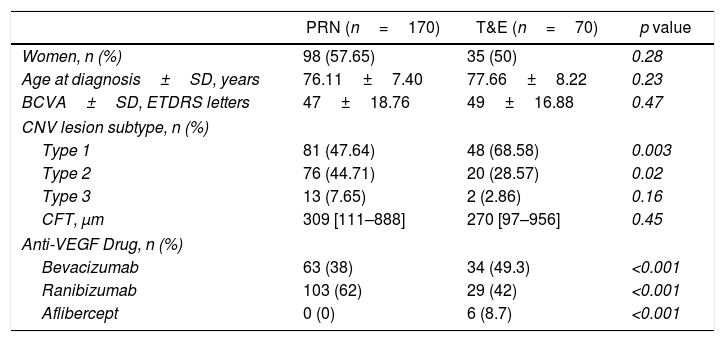Evaluar y comparar los resultados visuales y morfológicos de regímenes de tratamiento pro re nata (PRN) y tratar-y-extender (T&E) a tres años en la práctica clínica real.
MétodosUn estudio retrospectivo de pacientes con degeneración macular vinculada a la edad neovascular (DMEN) tratadas con anti-VEGF con tres años de seguimiento continuo y sin tratamientos anti-VEGF anteriores. Se midieron la mejor agudeza visual corregida (MAVC), el espesor foveal central (EFC) y el número de inyecciones intravítreas para determinar diferencias estadísticas entre ambos grupos al inicio y a lo largo del seguimiento.
ResultadosSe incluyeron en el estudio un total de 240 ojos, 170 en el grupo PRN y 70 en el grupo T&E. A los 12 meses la ganancia media con respecto al inicio de MAVC (en letras ETDRS) llegó a su punto más alto en el grupo T&E (+6,38±13,32; p=0,25). En el grupo PRN, MAVC llegó al máximo a los tres meses y disminuyó lentamente hasta el final del seguimiento.
Con ambos regímenes, desde el inicio el EFC continuó disminuyendo hasta el segundo año (PRN −138,81 [−846,7 a +162,77] y T&E −81 [−604 a +100] μm, p=0,06). Posteriormente, el grupo T&E mantuvo esta tendencia, llegando al nivel más bajo de EFC a los 36 meses, mientras que el grupo PRN mostró un aumento en los valores de EFC (PRN −104 [−807,7 a +297] μm y T&E −103 [−575 a +244], μm p=0,63). Los pacientes tratados con el régimen T&E recibieron un número significativamente mayor de inyecciones (PRN 16,3±7,6 vs. T&E 23,9±9,4, p<0,01).
ConclusiónLos resultados demostraron una tendencia de T&E a conseguir valores más altos de MAVC, llegando al máximo a los 12 meses, y grosores menores de EFC al final de tres años. A pesar del mayor número de inyecciones en el grupo T&E, la media de MAVC revirtió a los valores de base a los tres años.
Evaluate and compare the visual and morphological results of pro re nata (PRN) and treat-and-extend (T&E) treatment regimens at 3 years in real world clinical practice.
MethodsRetrospective study of patients with neovascular age macular degeneration (DMEV) treated with anti-VEGF with 3 years of continuous follow-up and no previous anti-VEGF treatment. Best corrected visual acuity (MAVC), central foveal thickness (EFC) and number of intravitreal injections outcomes were tested for statistical differences between the two groups at baseline and during follow-up.
ResultsA total of 240 eyes were included in the study, 170 in the PRN group and 70 in the T&E group. At 12 months, mean BCVA (ETDRS letters) gain from baseline was at its highest point in the T&E group (+6.38±13.32; p=0.25). In the PRN group, BCVA peaked at 3 months and slowly decreased until end of follow-up.
With both regimens, from baseline, CFT continued a decrease until the second year (PRN −138.81 [−846.7 to +162.77] and T&E −81 [−604 to +100] μm, p=0.06). After that, T&E group maintained this tendency, reaching the lowest CFT value at 36 months, whereas PRN group showed an increased in CFT values (PRN −104 [−807.7 to +297] μm and T&E −103 [−575 to +244], μm p=0.63). Patients treated with T&E regimen received a significantly higher number of injections (PRN 16.3±7.6 vs T&E 23.9±9.4, p<0.01).
ConclusionOur results demonstrated a trend toward for T&E a achieve higher marks in BCVA, peaking at 12 months, and lower CFT thickness at the end of three years. Despite the higher number of injections performed in the T&E group the mean BCVA reverts a baseline values at 3 year.











